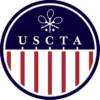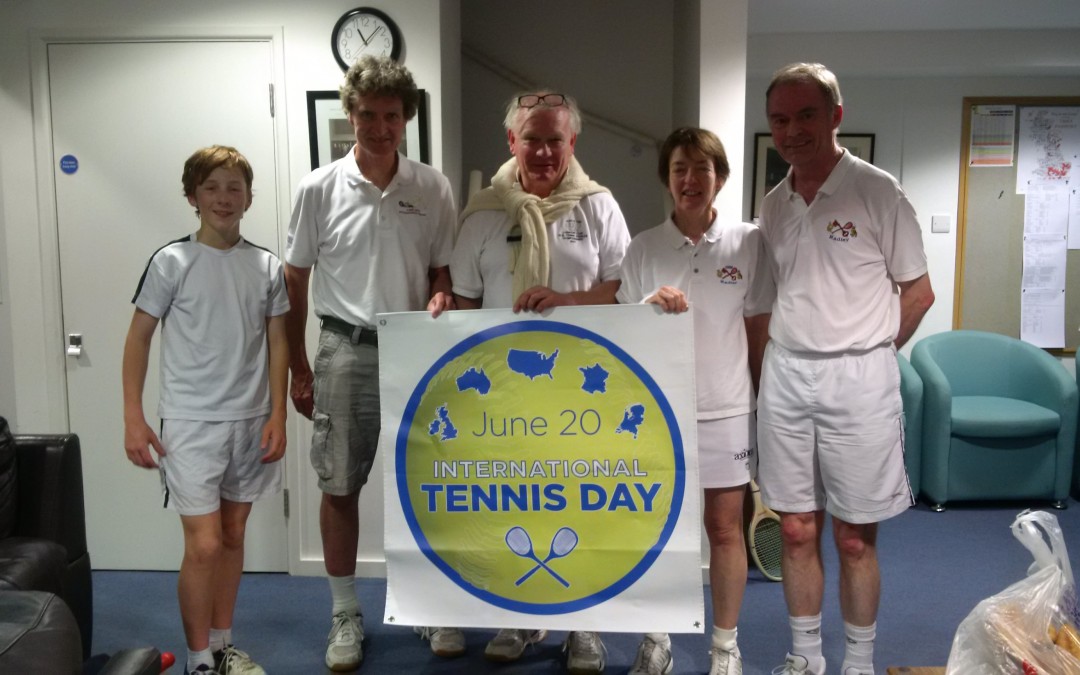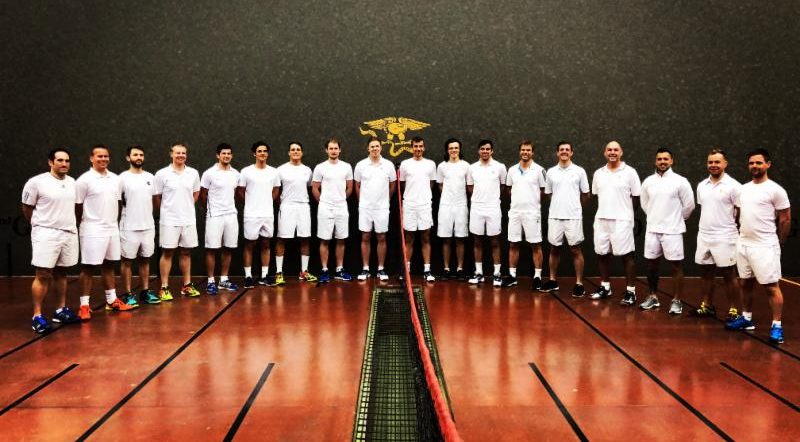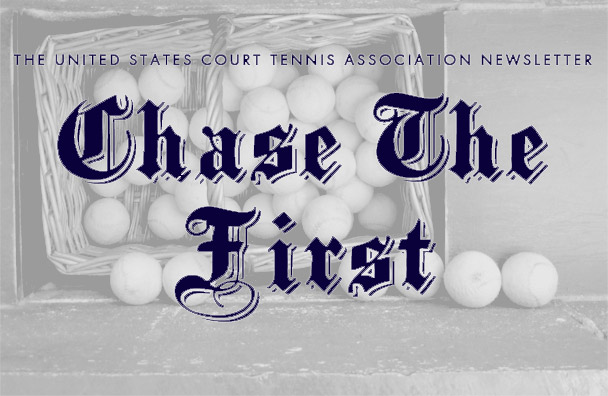by James Zug
Last year, the inaugural International Tennis Day was as much about getting the idea launched as anything else. Jon Crowell designed, produced and mailed handsome, sturdy ITD banners around the country and around the world; Kieran Booth ferried Australian’s allotment back Down Under.
Some people grasped the notion of simulataneously celebrating the great game of tennis around the globe, while others weren’t exactly sure about how to use the ITD page at Facebook or the ITD hashtag (#iTennisDay) on Twitter.
Nonetheless, the first ITD in 2014 was a success: clubs in all four playing nations held events, whether a special screening of a film about tennis in Philadelphia, a skills shootout in Aiken and in Hobart or lessons for juniors in Washington or simply spirited play in Paris. The highlight might have been Radley College, which hosted seventeen straight hours of play.
This year, ITD really came into its own. International Tennis Day is held on the anniversary of the Tennis Court Oath that precipitated. The 20th of June this year was a Saturday, which meant a bit less activity for some of the Northern Hemisphere city clubs, where summer was in full swing and most members were out of town.
But Saturday is always a busy day for younger players at Seacourt and so the English club held their weekly three hours of junior coaching sessions, starting with children as young as six, that culminated with young Max Jones winning the informal junior tournament. Then Seacourt hosted a six-hour afternoon of American doubles. After the confusion about what exactly American doubles was cleared up (it isn’t what players in the States call Canadian doubles, but rather regular doubles with people exchanging partners after every match), Matt Boulton won the event and was awarded a candy bar. the play was streamed live on the Internet. (They had to poke a tiny hole in the banner, about where Montana is in the outline of the U.S. in order to allow a camera to shoot from the grille.)
Others took advantage of the weekend date to take the ITD banner and tennis racquets out into the world. Last year the best version of this was when Irish Real Tennis Association gathered with banner & bats in front of the old Guinness court in downtown Dublin. This year the best moment might have been when the Tennis Channel’s broadcast from the Aegon Championships at Queen’s Club lingered on the ITD banner in the stands. Freddy Adam (who ferried ITD banners this year from the States to England) joined Cees de Bondt in Florence a search for tennis in Tuscany (trademark that). In New York, Michael Do, the USCTA photographer, introduced the game to lawn tennis players in Central Park. The last post at the ITD page at Facebook came all the way from Nepal—perhaps tennis will reach a fourth continent soon.
The ITD banner proudly was displayed in and around existing courts around the globe. The first court to see ITD play was Tasmania. Hobart hosted the Australian Ladies Championships and the Judith Clarke Trophy (the annual Hobart v. Melbourne women’s match), as well as players sneaking on court at dawn before the tournament resumed. A touring side from Prince’s Court in Washington played at Fontainebleau and Tuxedo hosting an inter-city with the rest of Prince’s Court; Newmarket played the Rose Bowl Tournament at Newmarket; Leamington hosted a club tournament; and Paris welcomed a touring side from Prested Hall. In Newport, Chicago and Philadelphia, players gathered behind or in front of the ITD banner after playing spirited games of tennis. In Washington, Haven Pell posted a video giving the elevator spiel to a newcomer to the game.
Just like last year, though, the hands-down winner for the most enthusiastic ITD club was Radley College. Seventeen hours was not enough. Maggie Henderson-Tew gave this report of perhaps the busiest twenty-four hours of tennis in history:
Play started at exactly midnight. Maggie Henderson-Tew and Rebecca Kashti got the day’s twenty-four hours of continuous play off to a non-compliant start. Their attire was certainly on the banned lists from all major sporting governing bodies. Rebecca came on to the court from a business awards dinner that her law firm sponsored, and so was wearing an elegant black cocktail dress and pearls. The pearls were removed and footwear changed, but she stayed in her dress to play. Maggie had planned to play in pyjamas, but felt significantly underdressed when Rebecca arrived, so changed back into her day dress, which featured every possible colour except T&RA-approved white or Rebecca’s black.
An hour later they were followed on court by an intrepid pair of young players, Walter Thompson and Vincent Graham, who had begged to be allowed to take the coveted 1-4am slot. Or was it that THEY had been begged to take the pre-dawn shift? Anyway, they played, with short drinks breaks, for three hours, completing sixty-four games and seven full sets. A heroic effort.
After some sleep, Maggie came back on court to play Nino Merola, who is moving to Washington to work with Ivan Ronaldson. Nino had not been to bed since Thursday night, but this did not show, as he played with characteristic power and crispness of shot. Maggie, trying to pace herself for what would be a long day, did not run everything down but ‘took a view’ on the fast or distant balls, i.e. most of them.
Toddy Hoare was next up against Nino, who stayed on to play the next club member who shall remain nameless. He rang to say his alarm had failed to go off and, given the distance he lives from the court, it made no sense for him to set out. Maggie went back on court with Nino and then Toddy, revitalised and fortified with coffee and bacon and sausage sandwiches, came back to play Maggie for the second half-hour.
It was now 7am and two new players arrived, including the Radley College bursar, the first college player of the day, but not be the last. His opponent, Edward Hess, always had a good eye for the dedans and the number of winning openings hit began to rise.
Played stopped at 8am. What? What about the twenty-fourhour claim? Not to worry. It was just competitive play that ceased for an hour, as pro Mark Eadle gave a lesson. This and two hours in the evening when players practised, were the only non-competitive hours in the day.
Players continued to stream in and out of the club all day, fortified by the breakfast, lunch, tea and supper that were available throughout. A team from Hardwick House arrived at 11am and departed at 5pm, having played a series of nine-game sets of doubles matches. But the Hardwick players were just one small part of the global nature of the play at Radley that day. There were American, Austrialian, English, Irish and Scottish players; among these were members of clubs including: Boston, Cambridge, Chicago, the Dutch Real Tennis Association, Falkland, Oxford, Hampton Court, Hardwick House, Hatfield House, Holyport, The Hyde, The Irish Real Tennis Association, The Ladies Real Tennis Association, Melbourne, Moreton Morell, Lord’s, Oratory, Queen’s, Prested Hall, Radley and the Tennis & Rackets Association—. The age range of players was fifteen to seventy-three and the handicap range was 1.3 to 76.7. Some were relatively new to the game and some had played for more than fifty years; two fathers played with their sons; there were three husband & wife doubles combinations; one former world champion; two former world number one players; a Davis Cup lawn tennis player; the holder of the current British U24 doubles title; and the majority, who didn’t dare of dream of winning a major title, but just played for the love of their wonderful sport.
For the record, thirty-seven players were involved in twenty-one hours of competitive play. Four hundred and twenty-one games and forty-three sets were contested. The ball entered the dedans eighty-five times, the grille was struck seventy-six times and there were nine winning galleries.
Particular mention should go to Nick and Sam Stogdon, Nigel Shaw and Brian Sutton, who each played for two hours, to the heroic efforts of Vincent Graham and Walter Thompson, who played continuously in the tough pre-dawn session and to Niño Merola who played from 04.00-06.00 and then came back twelve hours later for another stint. Maggie Henderson-Tew confirmed both her extreme enthusiasm for the game and her inability to do anything by halves, by playing a total of four singles and three doubles matches. She had the honour of playing the final match, against James Walton, from 11pm-12am, after which she and James had a glass of Pol Roger champagne and toasted the success of the day.
International Tennis Day: Uniting the Game Around the Globe.
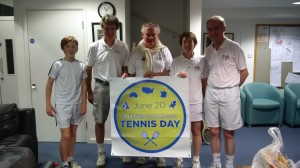
The penultimate and the final pair of players and the Pro who was there all through… 23 hours down and one to go on Sat 20 June. From the left, Benjamin Yorston , CJR, James Walton, Maggie Henderson-Tew and Brian Sutton.
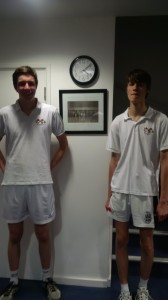
These young men, Vincent Graham and Walter Thompson, beat off all rivals for the coveted 1-4 am session this morning. This photo was taken, as you see, when they finished, and the exhaustion certainly shows. Each of them weighed approx 250lbs when they stepped on court, but you can see for yourself the effect of playing 64 games and completing 7 sets. Well done, chaps, and thank you VERY MUCH!
